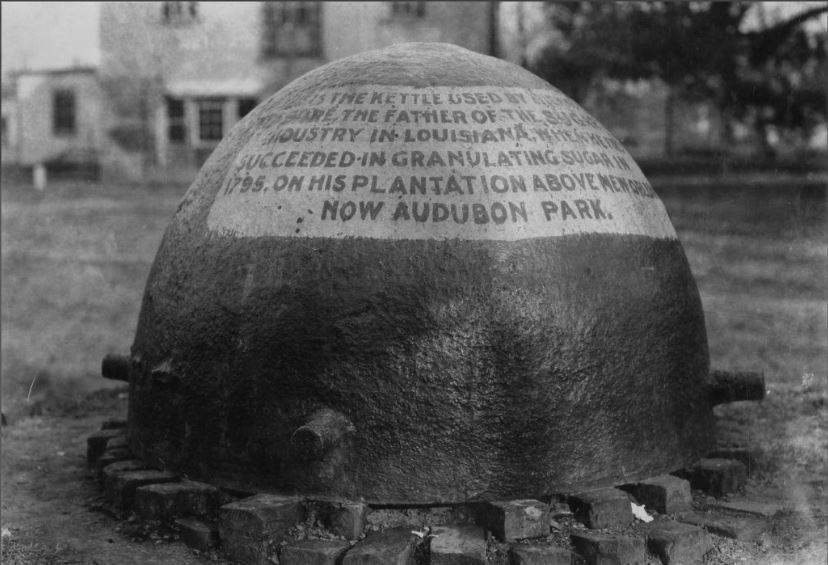Just outside LSU’s Chemical Engineering Building stands a rusted sugar kettle — a heavy, iron relic of Louisiana’s agricultural past. For decades, a historical marker nearby has claimed the kettle once belonged to Etienne de Boré, the Creole French planter credited with first granulating sugar in Louisiana. But according to LSU doctoral candidate and historian Logan Istre, that story is more myth than fact.
“I was doing a conference paper for the Louisiana Historical Association,” Istre said. “You always see this kettle, and I had never thought much of it. But I was researching Louisiana sugar planters and started asking, ‘How did this kettle get here? Is this legit?”
The answer, he discovered, was murky at best — and filled with contradictions, embellishments and gaps in recordkeeping.
There’s no official documentation in LSU’s archives tracing the kettle’s arrival, but Istre followed a trail of public records, newspaper clippings and personal letters that paint a much different story than the one on the plaque.
A foundry, a fire and a forgotten donation
The kettle arrived on campus in 1891, according to newspaper accounts from the time. Following its display outside what is now the Louisiana Old State Capitol in the 1850s as “the original sugar kettle,” it was reportedly stolen during the Civil War’s capitol fire and put to use by bootleggers for distilling rum.
It wasn’t until later that its historical significance was recognized by William Blackie, a Scottish-born foundry owner, who purchased it as scrap metal from a foundry previously owned by another Scottish emigrant, John Hill — a name that would later become entangled in the kettle’s misattributed origin.
Blackie recovered the kettle and buried it in a pit at his foundry, where it served as a clay receptacle for industrial work for two decades. Eventually, nearing retirement, he grew concerned for its future and donated it to LSU. The university was then located downtown, and its president at the time, James Nicholson, accepted the gift.
Blackie, according to Istre, “told Nicholson to paint the history on it, to document where it came from.” But within a few years, the facts began to shift.
A game of telephone
In the early 1890s, LSU was touring businessmen around campus when they came upon the sugar kettle. Nicholson — perhaps attempting to add grandeur to the school’s humble relic — claimed the kettle had once belonged to de Boré and that he’d picked it up in Donaldsonville.
Blackie was outraged. He wrote to the university to correct the story, and at the time, newspapers still credited him for the donation.
But as years passed and memories faded, Nicholson began mixing names in his retellings. Eventually, he said the kettle was donated by Blackie — but that Blackie had worked with John Hill, a significant donor to LSU and owner of the foundry before Blackie.
“By then, Blackie had died and couldn’t defend himself,” Istre said. “Hill was still alive, and I imagine he saw the kettle and said, ‘Oh yeah, that came from our foundry.’ People wanted to be nice to him. He was donating a lot of money.”
Decades later, in the 1930s, Hill’s grandson spun the tale further, telling a new version that credited John Hill himself as the donor of the kettle. This version stuck. The kettle was moved to the Hill Memorial Library, further cementing the association.
In the 1950s, it was relocated again, and by 1971, during the bicentennial push for historical preservation, LSU installed the current historical marker with the now-contested story.
Étienne De Boré
A French-educated chemist, de Boré is widely credited with successfully granulating sugar on a plantation near New Orleans in the 1790s — a breakthrough that helped launch Louisiana’s sugar industry.
Former LSU chemical engineering professor Louis Joseph Thibodeaux wrote that “The people were electrified. Etienne de Boré marketed $12,000 worth of superior sugar.”
De Boré worked closely with an enslaved man and skilled sugar refiner named Antoine Morin, whose role is often under-acknowledged.
De Boré’s grandson, Charles Gayarré, was a state legislator and historian. In 1856 — the same year the kettle appeared in Baton Rouge — Gayarré inherited the de Boré plantation and may have discovered old kettles during a barn cleanout. It’s possible that one of these found its way to the State Capitol and, eventually, into Blackie’s hands.
“The kettle is legit,” Istre said. “We’ll never know for sure if this is the kettle. But it’s more likely now that it was one of de Boré’s kettles. It comes from the right time period, and there’s a loose chain of custody. But the facts on the plaque need to be changed.”
Even faculty remain uncertain about the kettle’s history.
“Unfortunately, I don’t know anything about the kettle,” LSU History Department Chair Aaron Sheehan-Dean wrote in an email. “What I know I learned from Logan.”
Changing a historical marker
Correcting the historical record isn’t just a matter of good research — it’s a bureaucratic process. To update the plaque, the university must request approval from the Louisiana Department of Culture, Recreation, and Tourism.
But for Istre, it’s worth the effort.
He’s currently working with the university administration on changing the historical marker and plans to publish an article about the kettle in 64 Parishes, a magazine of the Louisiana Endowment for the Humanities.
“LSU has been nothing but accommodating and friendly,” he said. “They want to do this right.”
More than just a relic, LSU’s sugar kettle is a story in itself, and thanks to Istre, this long-silent fixture is finally poised to tell its true story.







